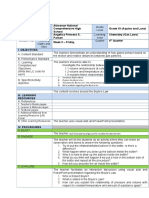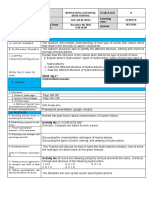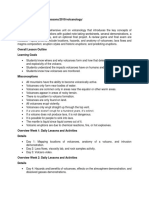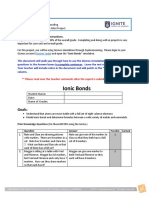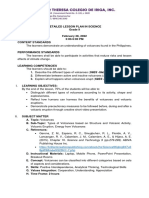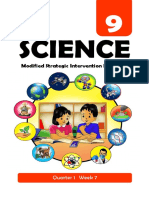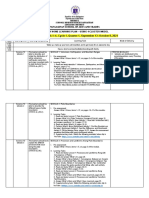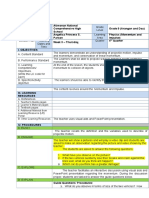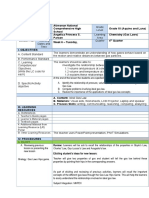ACTIVITY 3 Volcano
ACTIVITY 3 Volcano
Uploaded by
GelCess ParoanCopyright:
Available Formats
ACTIVITY 3 Volcano
ACTIVITY 3 Volcano
Uploaded by
GelCess ParoanOriginal Description:
Copyright
Available Formats
Share this document
Did you find this document useful?
Is this content inappropriate?
Copyright:
Available Formats
ACTIVITY 3 Volcano
ACTIVITY 3 Volcano
Uploaded by
GelCess ParoanCopyright:
Available Formats
ACTIVITY 3 Name: ___________________________________ Grade & Section: __________________Teacher: ____________________Score:
________
PART I. PART II. Read the passage below and answer the following questions:
1
o
2m
p
3 e
i
4 i
5
6 7
8
9
10
11
12 13
Across
2. Hot liquefied rock located deep below the Earth’s surface.
3. These types of volcanoes have very fluid lava that easily runs down the hill of the volcano
and travels long distances before cooling. They do not have very steep sides.
4. This type of volcano has steep slopes and contains thick, sticky lava.
7. This is a solid layer and is made of iron and nickel. It is the hottest part of the Earth and
can reach temperatures of up to 10,800ºF.
8. When a volcano erupts, this flows out of the volcano down the side of the mountain.
9. This portion of the Earth is approximately 1,802 miles thick and is made of magma. It is
the third deepest layer of the Earth.
10. An area of the Pacific Ocean that is shaped like a horseshoe. It is home to 90% of the
world’s earthquakes and 75% of the world’s volcanoes.
11. The liquid layer of the Earth that is made from molten iron and nickel. This liquid metal
creates the Earth’s magnetic field.
12. A type of volcano which last erupted thousands of years ago and will probably never erupt
again.
Down
1. The name of the Roman city that was buried underground by ash and volcanic debris when a
nearby volcano erupted in 79 B.C.E
4. This type of volcano is made up of scoria. It has a bowl-shaped crater at the top.
1. What are volcanoes, and how they are formed?
5. The mouth of a volcano. It surrounds the vent.
2. Where are volcanoes typically found, and why?
6. An opening in the surface of the Earth through which volcanic materials, such as magma,
can escape.
3. What are the three main types of volcanoes?
13. This is the outer layer of the Earth. It varies in thickness from 20-30 miles thick. It is 4. How can volcanic eruptions be destructive?
not even and is made up of pieces which overlap to cover the entire planet. 5. What instruments do scientists use to study
volcanoes?
You might also like
- Boyle's Law 7 E's Lesson PlanDocument2 pagesBoyle's Law 7 E's Lesson PlanGelCess Paroan75% (12)
- DLP Cot 2 2020Document3 pagesDLP Cot 2 2020GelCess Paroan89% (9)
- Hydrocarbons DLL FinalDocument2 pagesHydrocarbons DLL FinalJay-ar RiosNo ratings yet
- Topic 4 BondingDocument13 pagesTopic 4 Bondinglobna masadehNo ratings yet
- Geothermal Energy Is A Renewable Energy ResourceDocument2 pagesGeothermal Energy Is A Renewable Energy ResourceMichelle Oñas VillarealNo ratings yet
- Week1 DLL10Document8 pagesWeek1 DLL10Amy Villa100% (1)
- Volcano Lesson PlanDocument4 pagesVolcano Lesson PlanJhon Excell SanoNo ratings yet
- Panimula This Module Was Designed To Help You Master Knowledge and Concepts AboutDocument4 pagesPanimula This Module Was Designed To Help You Master Knowledge and Concepts AboutJazzy Anne AquinoNo ratings yet
- 19Document35 pages19Ailyn Ricor TawakalNo ratings yet
- Lesson Plan Volcano Grade 9 ScienceDocument5 pagesLesson Plan Volcano Grade 9 ScienceJerwin ForteoNo ratings yet
- San Francisco High School Science Grade 10Document3 pagesSan Francisco High School Science Grade 10Mrhadji SibolboroNo ratings yet
- Climate 1Document47 pagesClimate 1Princess Fiona AdvientoNo ratings yet
- Activity Sheet 2Document3 pagesActivity Sheet 2Anjhiene Camba100% (1)
- Lesson Plan Q3 COTDocument5 pagesLesson Plan Q3 COTCharmen PabilonaNo ratings yet
- School Grade Level Teacher Learning Area Time & Dates Quarter I. ObjectivesDocument4 pagesSchool Grade Level Teacher Learning Area Time & Dates Quarter I. ObjectivesRiztine Rachel RaineNo ratings yet
- 7 E Model Lesson PlanDocument7 pages7 E Model Lesson Plangloria tolentinoNo ratings yet
- Report On Least Learned Competencies in ScienceDocument2 pagesReport On Least Learned Competencies in ScienceRommel ZafraNo ratings yet
- Science9 ACTIVITY SHEET Physics Quarter I Week 5Document6 pagesScience9 ACTIVITY SHEET Physics Quarter I Week 5Ezzy SantosNo ratings yet
- DLL 2018 2019Document72 pagesDLL 2018 2019Dannielyn BuayaNo ratings yet
- Worksheet MomentumDocument5 pagesWorksheet MomentumSiti RohmahNo ratings yet
- Uniformly Accelerated Motion (Horizontal and Vertical)Document27 pagesUniformly Accelerated Motion (Horizontal and Vertical)Seth DelfinNo ratings yet
- Lesson Plan 2 Classify-Volcanoes-Historical-EruptionDocument5 pagesLesson Plan 2 Classify-Volcanoes-Historical-EruptionRey Bello MalicayNo ratings yet
- Key - Hydrocarbon - Ws Answer KeyDocument4 pagesKey - Hydrocarbon - Ws Answer Keygarciajeremiah070No ratings yet
- Chem03 IonicBondsv3Document8 pagesChem03 IonicBondsv3Charlie JohanningmeierNo ratings yet
- Iloilo Province Grade 9 Chemistry - Matter: Rosalina B. Inarsolin-Botong-Cabanbanan NHSDocument7 pagesIloilo Province Grade 9 Chemistry - Matter: Rosalina B. Inarsolin-Botong-Cabanbanan NHSCaryl Ann C. SernadillaNo ratings yet
- 1ST Mod. DLL Part 2 3RD QRTR G9Document8 pages1ST Mod. DLL Part 2 3RD QRTR G9DhangManongas-LlaboreVeteNo ratings yet
- Percent CompositionstoichiometrypptDocument16 pagesPercent CompositionstoichiometrypptKazuki Fujiyama100% (1)
- Lesson Plan in Science 9Document2 pagesLesson Plan in Science 9Phranxies Jean BlayaNo ratings yet
- Intervention Plan in ScieceDocument2 pagesIntervention Plan in ScieceMary Joy Suñiga DayupayNo ratings yet
- DLL - SCIENCE - 9 - Q3 - W5 2019finDocument5 pagesDLL - SCIENCE - 9 - Q3 - W5 2019finMary ApostolNo ratings yet
- Ed Tech Semi-Detailed LP On Extinction Written by Andrew T. OribianaDocument3 pagesEd Tech Semi-Detailed LP On Extinction Written by Andrew T. OribianaAndrew T. OribianaNo ratings yet
- San Quintin National High School Lesson Plan in Science 9Document3 pagesSan Quintin National High School Lesson Plan in Science 9Kimberly Gonzales De VeraNo ratings yet
- Learner's Activity Sheet: Science (Quarter III - Week 7)Document6 pagesLearner's Activity Sheet: Science (Quarter III - Week 7)Amimah GuroNo ratings yet
- VOLCANOESDocument37 pagesVOLCANOESrichele rectoNo ratings yet
- Volcanoes Lesson PlanDocument14 pagesVolcanoes Lesson PlanJohn Pin NaresNo ratings yet
- Costellation ActivityDocument4 pagesCostellation ActivityFranz Dominic Laus100% (1)
- Multiple Alleles and Sex Linked TraitsDocument4 pagesMultiple Alleles and Sex Linked TraitsTrisha Melrose MilanesNo ratings yet
- LP 2022Document6 pagesLP 2022Bert RoseteNo ratings yet
- BekxjsojdDocument11 pagesBekxjsojdethan elizaldeNo ratings yet
- Science: Modified Strategic Intervention MaterialsDocument24 pagesScience: Modified Strategic Intervention MaterialsRoxanne Manaloto100% (1)
- Factors Affecting Climate: 1.latitude 2.altitude 3.distance From The Sea 4.ocean Currents 5.land TopographyDocument54 pagesFactors Affecting Climate: 1.latitude 2.altitude 3.distance From The Sea 4.ocean Currents 5.land TopographyMeljean Kalaw CastilloNo ratings yet
- Activity - Camera and Human EyeDocument5 pagesActivity - Camera and Human EyeVincee SamsonNo ratings yet
- Daily Lesson Plan: Student Teacher Grade Level Teaching Date Learning Area Teaching Time Quarter I. ObjectivesDocument7 pagesDaily Lesson Plan: Student Teacher Grade Level Teaching Date Learning Area Teaching Time Quarter I. ObjectivesHazel LiwanagNo ratings yet
- GRADE 10, Week 1-4, Cycle 1, Quarter 1, September 13-October 8, 2021Document4 pagesGRADE 10, Week 1-4, Cycle 1, Quarter 1, September 13-October 8, 2021orlan sison100% (1)
- SCIENCE 9 - 1. W1 LAS The External and Internal Parts of VolcanoDocument1 pageSCIENCE 9 - 1. W1 LAS The External and Internal Parts of VolcanoAPRIL MULANo ratings yet
- Grade 9 Science Detailed Lesson Plan - Ntot 2018Document3 pagesGrade 9 Science Detailed Lesson Plan - Ntot 2018Jengkie PecanaNo ratings yet
- Activity Sheet 5Document1 pageActivity Sheet 5Pangangan NHSNo ratings yet
- LP ClimateDocument5 pagesLP Climatekorb3tb1tchNo ratings yet
- Week4 Q3 Science9Document4 pagesWeek4 Q3 Science9REYMART TANSIONGCONo ratings yet
- Supplemental Activities in Science 9 Quarter 2, Week 6Document2 pagesSupplemental Activities in Science 9 Quarter 2, Week 6Rose Ann ChavezNo ratings yet
- DLP in WEEK 2Document11 pagesDLP in WEEK 2DHENZY FABILLANONo ratings yet
- Final Semi Detailed Lesson Plan TemplateDocument10 pagesFinal Semi Detailed Lesson Plan TemplateJessie GernaleNo ratings yet
- DLP For Retooling Hybrid Teaching MoleDocument2 pagesDLP For Retooling Hybrid Teaching Molemaverick arquilloNo ratings yet
- Science 10 - Q2 - Week 1 - M1Document5 pagesScience 10 - Q2 - Week 1 - M1Aaron James Miranda100% (1)
- Semi Det. Geothermal 9 DaaDocument5 pagesSemi Det. Geothermal 9 DaaRjane CañeteNo ratings yet
- COT Lesson PlanDocument3 pagesCOT Lesson Planrose eden cabalonga100% (1)
- DLP Science 9 Q3 Week 2Document6 pagesDLP Science 9 Q3 Week 2Gabriel PachecoNo ratings yet
- Grade9 Unit 4 Heat Work and EnergyDocument25 pagesGrade9 Unit 4 Heat Work and EnergyRiaNo ratings yet
- DLL Environmentl IssueDocument5 pagesDLL Environmentl IssueRose Ann TuburanNo ratings yet
- EARTH SCIENCE Week 3, Day 4Document5 pagesEARTH SCIENCE Week 3, Day 4Leah Marie GonzalesNo ratings yet
- Science 8Document95 pagesScience 8Armia LozagaNo ratings yet
- LP Horizontal Dimension 4 2 24Document8 pagesLP Horizontal Dimension 4 2 24GelCess ParoanNo ratings yet
- Grade 9 SecondDocument3 pagesGrade 9 SecondGelCess ParoanNo ratings yet
- DLL Week 2 Science 9Document3 pagesDLL Week 2 Science 9GelCess ParoanNo ratings yet
- DLP Cot 1 2020 Free FallDocument3 pagesDLP Cot 1 2020 Free FallGelCess Paroan50% (2)
- DLP Cot 1Document3 pagesDLP Cot 1GelCess Paroan100% (1)
- Grade 10 Third Grading Examination in ScienceDocument3 pagesGrade 10 Third Grading Examination in ScienceGelCess ParoanNo ratings yet
- ConstellationsDocument56 pagesConstellationsGelCess ParoanNo ratings yet
- Combined Gas Law 7 E'sDocument5 pagesCombined Gas Law 7 E'sGelCess Paroan100% (1)
- Combined Gas Law 7 E'sDocument5 pagesCombined Gas Law 7 E'sGelCess Paroan100% (1)
